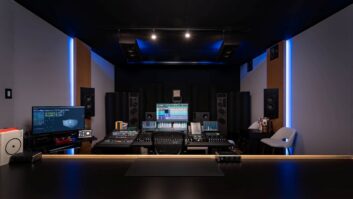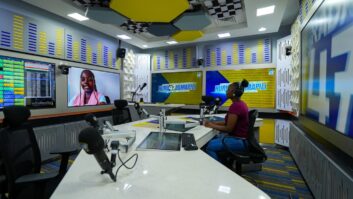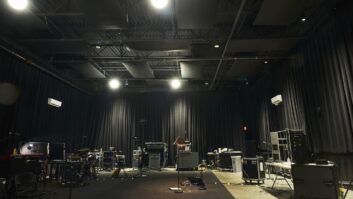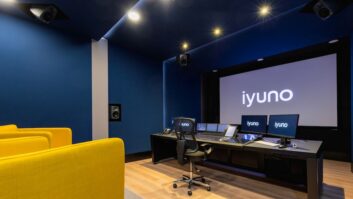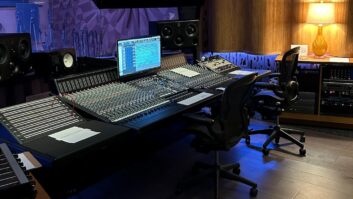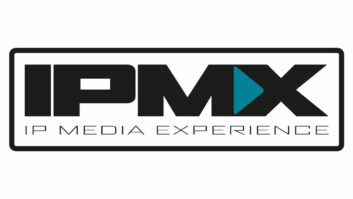Canada has been in the entertainment news a lot over the past year, usually because some Hollywood facility owner or representative in Congress is arguing that they aren’t playing fair when it comes to production. Local governments are offering tax breaks, they claim, and the U.S. dollar goes so much further that we’re losing our much-needed production dollars. Well, it’s too bad that all the energy is negative, because there are a lot of positives coming out of the Canadian production community. It’s just that we in the States rarely get a chance to see what’s really going on north of the border.
For years now, MuchMusic (Canada’s much-better-than-MTV music channel) has been on the street, capturing music on-the-fly- not just videos but hundreds of concerts and in-studio performances. You never know where their cameras are going to be next. These days, you can find the MuchMusic crew in a historic building in the hip Queen West district of Toronto.
Now known as the ChumCity building, the structure that serves as MuchMusic’s new studio was built in 1914 to house the administrative offices of the Methodist Church. It is one of the finest examples of Industrial Gothic architecture in Toronto. This building is now home to a modern day church: the church of television, and this is television like you’ve never seen before.
There is a constant buzz of energy at the station. Cameras and lights are everywhere, even on the street, because the whole environment is a shooting stage. The public can watch everything that happens through a set of extremely large windows between the stage and the street.
Events such as the MuchMusic Video Awards-using more than 600 channels of audio from five studios in the facility-are staged live outside the building and broadcast across Canada and to the international Much affiliates. Virtually all of the major acts that pass through Toronto (including David Bowie, Kid Rock, Alanis Morissette, Smashing Pumpkins and Spice Girls, to name just a few recent guests) end up performing or being interviewed live at the facility. The new studios were designed in order to expand the facilities and meet the upgrade needs of new developments in audio for TV. Although most stations are broadcasting in stereo, and some of the programming is in the Dolby ProLogic format, MuchMusic sees that 5.1 and HDTV are on the horizon.
The senior audio engineers at MuchMusic-Peter Lederer, Duane Atamanenke, Anthony Montano and Richard Ciavarella-teamed up with manager of operations Phil Dinan and Toronto design firm Pilchner Schoustal International to create the new recording and mix studio. Moses Znaimer, president and executive producer, had final approval of all plans. “The number one mandate from Moses was, ‘Don’t make it look like a bunker,'” says Dinan.
“Since the culture of MuchMusic is based upon exposure to the public,” says Martin Pilchner of Pilchner Schoustal, “one of the most critical demands placed upon the design came from the top [Znaimer]. Tours run through the station on a regular basis. The control room must remain highly visible to the public. So, as much glazing was implemented as possible, without adversely affecting the integrity and accuracy of the monitoring system and the acoustics of the space.” Indeed, the rear wall of the studio, which faces a hallway on the tour route, is made from custom-built Clear Plexi RPG Diffusor arrays.
The studio is adjacent to the occasionally very loud shooting space. Some of the criteria of the design included maximizing visual contact with the surrounding areas, optimizing room acoustics for 5.1 monitoring and a high degree of sound isolation. Rick Schoustal says, “It’s isolation without isolation. MuchMusic is all about interaction; thus, visual openness is key.” The control room features a 6-inch floating concrete floor with integrated steel cable management troughing and weighs in at 18.5 tons. It is 3,200 cubic feet with 1-inch and 31/44-inch laminated glazing on the rear, side and front walls.
Other features include integrated low-frequency damping acoustic treatments, namely Pilchner Schoustal’s proprietary controlled reflection room geometry with specular absorption, placed according to speaker dispersion. “The sound isolation is critical since they sometimes mix with measured outside levels in excess of 115 dB,” Schoustal adds. Stage lighting systems are located in the studio control room to allow the area to double as a set for artist interviews.
“Peter, Anthony and Duane have been the driving force behind the project,” Dinan says. “They have made all the crucial [equipment] decisions, because they are the guys that have to use it.” The team chose the Studer D950S as the mixing desk. “It was the integrity of the sound of the system,” Montano says of the decision. “The board was true to what you were recording. Two years ago in Switzerland we put that board through its paces with the design team.” Lederer says: “The console has redundancy on almost everything. After all, we are broadcast.”
Their D950 has 32 physical fader strips in a 40-strip frame. Each strip is ten layers deep, which allows up to 320 channels to be brought to the surface. Channels can also appear in multiple locations on the desk, which allows for speed. Each side of the desk can be controlled independently for multiple-person operation. In addition to the extensive “normal” panning facilities, including 5.1, Dolby EX and 7.1, the D950 features Studer’s proprietary VirtualSurround Panning system. VSP allows 3-D control of pan placement and movement and is frequency-dependent with automatic echo generation. The console includes the D19 MicAD for remote recording. “We want to integrate surround as a live part of our show,” Montana says, “not as something added later in post.”
“This unit allows us up to 56 remote microphone preamps,” Lederer adds. “On the wall panels, in every recording room, we ran a MADI (fiber) connection to the console.” The D19M MUX card frame contains line level A/D converters, AES3 input modules, and fiber-optic output modules. Analog and AES3 signals are converted to an optical MADI signal for transmission to MADI inputs on the DSP core. The remote unit operates under control from the D950. Being a TV station, there are many format and operator shifts throughout the day. With the D950, these changes are not a problem because every parameter of the board can be switched instantly so that each operator can access his or her own setup. The desk easily switches among configurations as well as between operators.
The 5.1 monitoring system is all-Genelec, with five soffit-mounted 1032s and a 1092 subwoofer. “We have almost every kind of audio monitor in the building,” Montana says. “We chose Genelecs because they are a consistent speaker for music.”
MuchMusic will be using eight 20-bit Studer V-Eight (ADAT II) machines (with Studer 24-bit A/D and D/A conversion) as the recording medium, with the V-Eight Cockpit remote control. The outboard rack includes gear from Eventide, Focusrite, Lexicon, TC Electronic and many more.
The new studio will be used for a variety of purposes. “Live Flow” occurs throughout the day-a combination of live VJ interviews and rock videos. There are many format changes, from various live locations to tape to commercials. There’s also the I&I (“Intimate and Interactive”) show, in which a VJ interviews musicians in front of a live audience; there are questions from both the in-house audience and at-home TV audience. Then there are live performances outside the building or on the soundstage, which are broadcast and recorded a few times a week. And every year MuchMusic has its awards show, which has featured artists such as David Bowie, Red Hot Chili Peppers, Britney Spears, Our Lady Peace, Len and many others.
It gets hairy, but the technical staff works to make guest performers comfortable. “Musicians come into MuchMusic and they feel at home,” Montano says. “They are confident that we know what we’re doing when it comes to music.”
The MuchMusic principals offer their special thanks to the installation team: Bruce Cowen, engineering manager; Lane Steinhauer, supervisor of technical facilities; and Reg Simard and Warren Spagn, for in-house finish carpentry.
Find out more about MuchMusic by visiting www.muchmusic.com.

